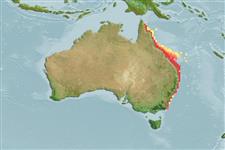Environment: milieu / climate zone / depth range / distribution range
Écologie
marin; saumâtre démersal; non migrateur; profondeur 0 - 50 m (Ref. 6205). Subtropical; 12°S - 39°S, 143°E - 157°E (Ref. 6205)
Western Pacific: endemic to Australia. Records of this species from western Australia or northern Australia refer to Sillago burrus. Also very similar to Sillago aeolus from southeast Asia (Sunda Shelf). Occurrence in Tanzania (Ref. 2871) is probably a misidentification.
Length at first maturity / Taille / Poids / Âge
Maturity: Lm 19.0 range ? - ? cm
Max length : 30.0 cm TL mâle / non sexé; (Ref. 6205); common length : 25.0 cm SL mâle / non sexé; (Ref. 9679)
Épines dorsales (Total): 12 - 13; Rayons mous dorsaux (Total): 19-21; Épines anales 2; Rayons mous anaux: 19 - 20; Vertèbres: 34 - 36. Anterolateral extensions of swim bladder recurved posteriorly to reach level of vent. Base of pectoral fin with black spot, back and sides with dark blotches. The upper and lower blotches are frequently joined, at least posteriorly, the upper blotches are generally larger; the opercle is dull or with an inner dark blotch showing through. Coloration is similar to S. burrus and S. aeolus.
Occur on silty and muddy substrates in the deeper water of bays, but also frequenting the mouths of rivers, estuaries, and mangrove creeks. Juveniles abound in estuaries and shallow water during summer, moving deeper as they mature. Diet of juveniles consist largely of small crustaceans and that of the adult fish consist mainly of polychaete worms and bivalve mollusks. Oviparous (Ref. 205). Spawn throughout the year with peaks in Dec.-Feb. (Ref. 6390). Marketed fresh (Ref. 9987) and chilled (Ref. 6390).
They spawn several times each year (Ref. 26745).
McKay, R.J., 1992. FAO Species Catalogue. Vol. 14. Sillaginid fishes of the world (family Sillaginidae). An annotated and illustrated catalogue of the sillago, smelt or Indo-Pacific whiting species known to date. Rome: FAO. FAO Fish. Synop. 125(14):87p. (Ref. 6205)
Statut dans la liste rouge de l'IUCN (Ref. 130435)
Menace pour l'homme
Harmless
Utilisations par l'homme
Pêcheries: intérêt commercial mineur; Aquaculture: expérimental; pêche sportive: oui
Outils
Articles particuliers
Télécharger en XML
Sources Internet
Estimates based on models
Preferred temperature (Ref.
123201): 20.2 - 26.9, mean 25.1 °C (based on 98 cells).
Phylogenetic diversity index (Ref.
82804): PD
50 = 0.5000 [Uniqueness, from 0.5 = low to 2.0 = high].
Bayesian length-weight: a=0.00631 (0.00372 - 0.01070), b=3.10 (2.95 - 3.25), in cm total length, based on LWR estimates for this species & Genus-body shape (Ref.
93245).
Niveau trophique (Ref.
69278): 3.3 ±0.1 se; based on diet studies.
Résilience (Ref.
120179): Haut, temps minimum de doublement de population inférieur à 15 mois (Preliminary K or Fecundity.).
Fishing Vulnerability (Ref.
59153): Low vulnerability (20 of 100).
Nutrients (Ref.
124155): Calcium = 349 [80, 974] mg/100g; Iron = 1.27 [0.47, 3.58] mg/100g; Protein = 20.9 [18.2, 23.2] %; Omega3 = 0.235 [0.104, 0.516] g/100g; Selenium = 20.5 [6.3, 76.8] μg/100g; VitaminA = 20.7 [4.0, 113.7] μg/100g; Zinc = 0.976 [0.489, 2.344] mg/100g (wet weight);
